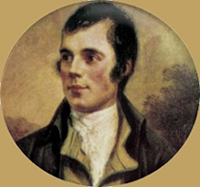The Robert Burns Connection

The Jamaican voyage Burns never took
IAIN LUNDY
ROBERT Burns had everything needed to become an icon in his native
Scotland. He was working class and had to overcome grinding poverty before
finding success. He was also, to put it mildly, a bit of a lad - part
incorrigible womaniser, part dashing romantic - and to lift his spirits he
liked a good drink. He then died tragically young. Scots celebrate him as
their national Bard because most can, in some way, identify with him.
Yet what few people realise is that, before he found fame, Scotland
very nearly lost Burns - to Jamaica. It was a mighty close thing and had
certain events at the most crucial point in his life turned out
differently, Burns would have been gone.
It is difficult to imagine the literary and cultural life of Scotland
without Burns: No Tam o’ Shanter, no Auld Lang Syne,
no Man’s A Man For A’ That, no Burns Suppers. The country
would have been bereft of all this - and much, much more - if Burns had,
as planned, boarded the two-masted brigantine Nancy at Greenock and sailed
to the West Indies to make his fortune.
It was to be no flight of fancy on the part of Burns. He had put down
nine guineas deposit and secured steerage passage on the Nancy. Moreover
he had a job to go to in Jamaica, as a bookkeeper on an estate in the town
of Port Antonio, owned by one of his friends, Dr Patrick Douglas.
Burns had negotiated a three-year contract at a wage of £30 a year. He
firmly believed he would never see his native land again. In late August
1786 a melancholy Burns wrote:
"Farewell, my friends, farewell, my foes!
My peace with these, my love with those.
The bursting tears my heart declare—
Farewell the bonnie banks of Ayr!"
The roots of his misery and woe were fairly obvious to his large circle
of friends in Ayrshire. For a start he was penniless, the farm at Mossgiel,
near Mauchline, which he and his brother Gilbert owned was so unproductive
that the two men were earning only seven pounds a year each.
His various romantic liaisons were also becoming increasingly
complicated. Burns had already fathered one child, Bess, in 1785, the
result of an affair with family servant Elizabeth Paton. In early 1786 he
discovered that his new sweetheart and wife-to-be Jean Armour, was also
pregnant. The news was received very badly by Jean’s father, "Old
Armour", as Burns called him. He fiercely opposed the idea of an
impoverished farmer marrying his daughter and pursued Burns through the
courts for maintenance.
Burns found solace the only way he knew how - with another woman, Mary
Campbell or "Highland Mary". She was from Dunoon and Burns
became so infatuated with her that, in May that year, the two lovers
pledged themselves to each other by standing on either side of the River
Ayr and exchanging bibles. Burns resolved that when he sailed for Jamaica,
Mary would sail with him. He needed only the £20 to purchase tickets for
them both.
What took place between August and October 1786 changed the face of
Scottish culture and of world literature. Burns was persuaded to publish a
book of his poetry to raise money for the trip. The Nancy, due to leave
Greenock on 10 August with freight and passengers bound for the Jamaican
port of Savannah-la-Mar, was delayed until 5 September.
Then, on 3 September, Jean Armour gave birth to twins, Jean and Robert.
This delighted him as did the news that the 612 copies of his book, Poems,
Chiefly in the Scottish Dialect, were selling like hot cakes thanks
in no small measure to a glittering review in the Edinburgh press by the
Rev Dr Thomas Blacklock, an influential figure in the literary world. The Kilmarnock
Edition, as the book became known, had elevated him to celebrity
status.
In October came news that Mary Campbell, while waiting at a
relative’s house in Greenock, had contracted a fever and died.
It was enough to make him abandon all plans of sailing to Jamaica. With
his new-found wealth and status he headed, instead, for Edinburgh. The
rest, as they say, is history.
Robert Burns wrote of James, the
second Earl of Douglas and Mar, the hero of Otterburn:
" One Douglas lives in Home's immortal page,
But Douglases were heroes every age."
See also:
Douglases with Burns connections
Burns and slavery


